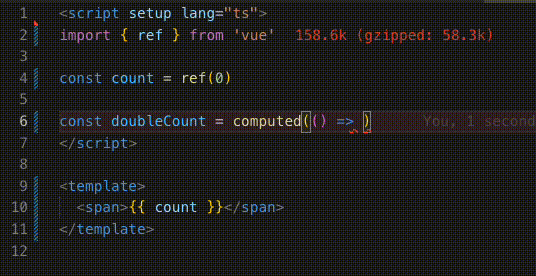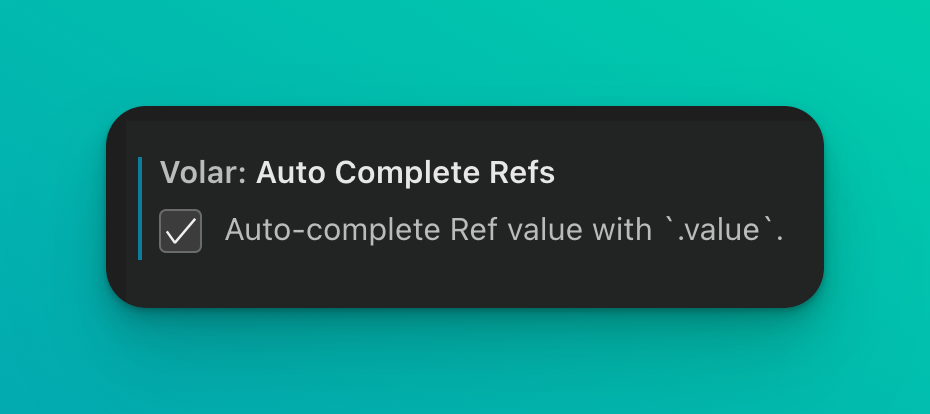ref() vs. reactive()
What to choose using Vue 3 Composition API?
Vue.js Live on May 15th, 2023
Michael Hoffmann
Senior Frontend Developer- Freelancer focused on Vue.js
- +7 years of professional experience
- Munich, Germany 🇩🇪
- Weekly newsletter: weekly-vue.news
- Blog & Portfolio: mokkapps.de
- Say hi at @mokkapps

ref() vs. reactive()
What to choose using Vue 3 Composition API?
Vue.js Live on May 15th, 2023
Michael Hoffmann
Senior Frontend Developer- Freelancer focused on Vue.js
- +7 years of professional experience
- Munich, Germany 🇩🇪
- Weekly newsletter: weekly-vue.news
- Blog & Portfolio: mokkapps.de
- Say hi at @mokkapps

Agenda
- Reactivity in Vue 3
- reactive()
- ref()
- reactive() vs. ref()
- Conclusion
Reactivity in Vue 3
What is reactivity?
And why does Vue need it?
A reactivity system is a mechanism that automatically keeps in sync a data source (model) with a data representation (view) layer.
Every time the model changes, the view is re-rendered to reflect the changes.
It’s a crucial mechanism for any web framework.
JavaScript is not reactive per default
Let’s take a look at a code example:
let price = 10.0 const quantity = 2 const total = price * quantity console.log(total) // 20 price = 20.0 console.log(total) // ⚠️ total is still 20let price = 10.0 const quantity = 2 const total = price * quantity console.log(total) // 20 price = 20.0 console.log(total) // ⚠️ total is still 20
In a reactivity system, we expect that total is updated each time price or quantity is changed.
But JavaScript usually doesn’t work like this.
The Vue framework had to implement a mechanism to track the reading and writing of local variables.
How Vue implements reactivity
It works by intercepting the reading and writing of object properties
Vue 3 uses Proxies for reactive objects and getters/setters for refs
function reactive(obj) { return new Proxy(obj, { get(target, key) { track(target, key) return target[key] }, set(target, key, value) { target[key] = value trigger(target, key) }, }) }function reactive(obj) { return new Proxy(obj, { get(target, key) { track(target, key) return target[key] }, set(target, key, value) { target[key] = value trigger(target, key) }, }) }
Vue 2 used object getters/setters exclusively due to browser limitations
reactive()
reactive()
Returns a reactive proxy of the provided object
import { reactive } from 'vue' const state = reactive({ count: 0 })import { reactive } from 'vue' const state = reactive({ count: 0 })
This state is deeply reactive by default:
import { reactive, watch } from 'vue' const state = reactive({ count: 0, nested: { count: 0 }, }) watch(state, () => console.log(state)) // "{ count: 0, nested: { count: 0 } }" const incrementNestedCount = () => { state.nested.count += 1 // Triggers watcher -> "{ count: 0, nested: { count: 1 } }" }import { reactive, watch } from 'vue' const state = reactive({ count: 0, nested: { count: 0 }, }) watch(state, () => console.log(state)) // "{ count: 0, nested: { count: 0 } }" const incrementNestedCount = () => { state.nested.count += 1 // Triggers watcher -> "{ count: 0, nested: { count: 1 } }" }
Limitations of reactive()
Limitations of reactive()
The reactive() API has two limitations:
It only works on object types and doesn’t work with primitive types
The returned proxy object from reactive() doesn’t have the same identity as the original object
const plainJsObject = {} const proxy = reactive(plainJsObject) // proxy is NOT equal to the original plain JS object. console.log(proxy === plainJsObject) // falseconst plainJsObject = {} const proxy = reactive(plainJsObject) // proxy is NOT equal to the original plain JS object. console.log(proxy === plainJsObject) // false
Problem 1: Reactive Proxy vs. Original
Reactivity is lost if you destructure a reactive object’s property into a local variable
const state = reactive({ count: 0, }) let { count } = state // ⚠️ count is now a local variable disconnected from state.count count += 1 // ⚠️ Does not affect original stateconst state = reactive({ count: 0, }) let { count } = state // ⚠️ count is now a local variable disconnected from state.count count += 1 // ⚠️ Does not affect original state
toRefs solves that problem:
import { toRefs } from 'vue' let state = reactive({ count: 0, }) const { count } = toRefs(state) // count is a ref, maintaining reactivityimport { toRefs } from 'vue' let state = reactive({ count: 0, }) const { count } = toRefs(state) // count is a ref, maintaining reactivity
Problem 2: Reactive Proxy vs. Original
Reactivity is lost if you try to reassign a reactive value
let state = reactive({ count: 0, }) watch(state, () => console.log(state)) // "{ count: 0 }" state = reactive({ count: 10, }) // ⚠️ The above reference ({ count: 0 }) is no longer being tracked (reactivity connection is lost!) // ⚠️ The watcher doesn't firelet state = reactive({ count: 0, }) watch(state, () => console.log(state)) // "{ count: 0 }" state = reactive({ count: 10, }) // ⚠️ The above reference ({ count: 0 }) is no longer being tracked (reactivity connection is lost!) // ⚠️ The watcher doesn't fire
Problem 3: Reactive Proxy vs. Original Problem
Reactivity connection is also lost if you pass a property into a function
const state = reactive({ count: 0, }) const useFoo = (count) => { // ⚠️ Here count is a plain number and not reactive } useFoo(state.count)const state = reactive({ count: 0, }) const useFoo = (count) => { // ⚠️ Here count is a plain number and not reactive } useFoo(state.count)
A Good Choice for Composition API Migration
reactive works very similarly to reactive properties inside of the data field:
<script> export default { data() { count: 0, name: 'MyCounter' }, methods: { increment() { this.count += 1; }, } }; </script><script> export default { data() { count: 0, name: 'MyCounter' }, methods: { increment() { this.count += 1; }, } }; </script>
You can simply copy everything from data into reactive to migrate this component to Composition API:
<script setup> setup() { // Equivalent to "data" in Options API const state = reactive({ count: 0, name: 'MyCounter' }); const {count, name} = toRefs(state) // Equivalent to "methods" in Options API increment(username) { state.count += 1; } } </script<script setup> setup() { // Equivalent to "data" in Options API const state = reactive({ count: 0, name: 'MyCounter' }); const {count, name} = toRefs(state) // Equivalent to "methods" in Options API increment(username) { state.count += 1; } } </script
ref()
ref()
ref() addresses the limitations of reactive()
ref() is not limited to object types but can hold any value type:
import { ref } from 'vue' const count = ref(0) const state = ref({ count: 0 })import { ref } from 'vue' const count = ref(0) const state = ref({ count: 0 })
To read & write the reactive variable created with ref(), you need to access it with the .value property:
const count = ref(0) console.log(count) // { value: 0 } console.log(count.value) // 0 count.value = 2 console.log(count.value) // 2const count = ref(0) console.log(count) // { value: 0 } console.log(count.value) // 0 count.value = 2 console.log(count.value) // 2
ref() internals
How can ref() hold primitive values?
function ref(value) { const refObject = { get value() { track(refObject, 'value') return value }, set value(newValue) { value = newValue trigger(refObject, 'value') } } return refObject }function ref(value) { const refObject = { get value() { track(refObject, 'value') return value }, set value(newValue) { value = newValue trigger(refObject, 'value') } } return refObject }
For object types, ref() is using reactive() under the hood:
ref({}) ~= ref(reactive({}))ref({}) ~= ref(reactive({}))
Destructuring ref()
Reactivity is lost if you destructure a reactive object created with ref()
import { ref } from 'vue' const count = ref(0) const { value: countDestructured } = count // ⚠️ disconnects reactivity, countDestructured is a plain number const countValue = count.value // ⚠️ disconnects reactivity, countValue is a plain numberimport { ref } from 'vue' const count = ref(0) const { value: countDestructured } = count // ⚠️ disconnects reactivity, countDestructured is a plain number const countValue = count.value // ⚠️ disconnects reactivity, countValue is a plain number
But reactivity is not lost if refs are grouped in a plain JavaScript object:
const state = { count: ref(1), name: ref('Michael'), } const { count, name } = state // count & name are still reactiveconst state = { count: ref(1), name: ref('Michael'), } const { count, name } = state // count & name are still reactive
Passing ref into functions
Refs can be passed into functions without losing reactivity
const state = { count: ref(1), name: ref('Michael'), } const useFoo = (count) => { // count is a ref and fully reactive } useFoo(state.count)const state = { count: ref(1), name: ref('Michael'), } const useFoo = (count) => { // count is a ref and fully reactive } useFoo(state.count)
This capability is quite important as it is frequently used when extracting logic into Composable Functions
Replacing ref object
A ref containing an object value can reactively replace the entire object
const state = ref({ count: 1, name: 'Michael', }) state.value = { count: 2, name: 'Chris', } // state is still reactiveconst state = ref({ count: 1, name: 'Michael', }) state.value = { count: 2, name: 'Chris', } // state is still reactive
Unwrapping refs
Vue helps us unwrapping refs without calling .value everywhere
Template Unwrapping
Vue automatically "unwraps" a ref when you call it in a template:
<script setup> import { ref } from 'vue' const count = ref(0) </script> <template> <span> <!-- no .value needed --> {{ count }} </span> </template><script setup> import { ref } from 'vue' const count = ref(0) </script> <template> <span> <!-- no .value needed --> {{ count }} </span> </template>
Watcher Unwrapping
We can directly pass a ref as a watcher dependency:
import { watch, ref } from 'vue' const count = ref(0) watch(count, (newCount) => console.log(newCount)) // no .value neededimport { watch, ref } from 'vue' const count = ref(0) watch(count, (newCount) => console.log(newCount)) // no .value needed
Unwrapping refs with unref()
unref() is a handy utility function that is especially useful if your value could be a ref:
import { ref, unref } from 'vue' const count = ref(0) const name = 'Michael' const unwrappedCount = unref(count) console.log(unwrappedCount) // 0 const unwrappedName = unref(name) console.log(name) // 'Michael'import { ref, unref } from 'vue' const count = ref(0) const name = 'Michael' const unwrappedCount = unref(count) console.log(unwrappedCount) // 0 const unwrappedName = unref(name) console.log(name) // 'Michael'
unref() is a sugar function for isRef(count) ? count.value : count
reactive() vs. ref()
reactive() vs. ref()
| reactive | ref |
|---|---|
| 👎 only works on object types | 👍 works with any value |
👍 no difference in accessing values in <script> and <template> | 👎 accessing values in <script> and <template> behaves differently |
| 👎 re-assigning a new object "disconnects" reactivity | 👍 object references can be reassigned |
🫱 properties can be accessed without .value | 🫱 need to use .value to access properties |
| 👍 references can be passed across functions | |
| 👎 destructured values are not reactive | |
| 👍 Similar to Vue 2’s data object |
Conclusion
My Opinion
What I like most about ref is that you know that it’s a reactive value if you see that its property is accessed via .value.
It’s not that clear if you use an object that is created with reactive:
anyObject.property = 'new' // anyObject could be a plain JS object or a reactive object anyRef.value = 'new' // likely a refanyObject.property = 'new' // anyObject could be a plain JS object or a reactive object anyRef.value = 'new' // likely a ref
Composing ref() and reactive()
A recommended pattern is to group refs inside a reactive object:
const loading = ref(true) const error = ref(null) const state = reactive({ loading, error, }) // You can watch the reactive object... watchEffect(() => console.log(state.loading)) // ...and the ref directly watch(loading, () => console.log('loading has changed')) setTimeout(() => { loading.value = false // Triggers both watchers }, 500)const loading = ref(true) const error = ref(null) const state = reactive({ loading, error, }) // You can watch the reactive object... watchEffect(() => console.log(state.loading)) // ...and the ref directly watch(loading, () => console.log('loading has changed')) setTimeout(() => { loading.value = false // Triggers both watchers }, 500)
Opinions from Vue Community
Twitter Poll
Opinions from Vue Community
The amazing Michael Thiessen wrote a brilliant in-depth article about this topic and collected the opinions of famous people in the Vue community:
- Eduardo, creator of Pinia
- Daniel Roe, leader of the Nuxt team
- Matt from LearnVue
- and more…
Summarized, they all use ref by default and reactive when they need to group things.
Final Words
So, should you use ref or reactive?
My recommendation is to use ref by default and reactive when you need to group things.
The Vue community has the same opinion but it’s totally fine if you decide to use reactive by default.
Both ref and reactive are powerful tools to create reactive variables in Vue 3.
You can even use both of them without any technical drawbacks.
Just pick the one you like and try to stay consistent in how you write your code!

